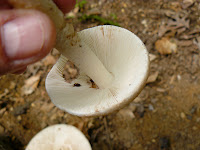Yesterday, at the playground with my daughter, I spotted this one growing under a pine tree. The big and white cluster shined against the grass and the pine trunk making it easy to spot from the distance. This made me wonder about how easy it is to find plenty of mushrooms even on a highly urbanized area like the one where I live.
Location: Rockville, MD
Date: 05/10/2010
Habitat: Cluster of three specimens, growing under live pine, caespitose (3 specimens connected through the stipe in the shape of a trident).
 Measurements
Measurements

Pileus diameter - 35 mm | 70 mm | 80 mm
Pileus height - 10 mm | 17 mm | 18 mm
Stipe length - 35 mm | 43 mm | 41 mm
Stipe diameter at apex - 7.5 mm | 10.5 mm | 13.5 mm
Stipe diameter at middle - 6.0 mm | 9.5 mm | 12.5 mm
Stipe diameter at base - 5.7 mm | 11.5 mm | 10.0 mm
Description
Pileus - light cream color with brown, concentric scales looking like remnants of the universal veil, scales can be detached with a little effort, cuticle is dull, dry. Shape is round, convex to flat, narrowly depressed. Margin is inrolled, tinted light yellow, somewhat eroded. Smell is fragrant but non-distinctive. Flesh is white.
Hymenium - gilled, gills are white, attached and sub-decurrent, subdistant, moderately broad, somewhat eroded.

Stipe - central, solid, flexible, radicated, equal, scabrous. Flesh is white, does not bruise any color upon cutting, when young surface seems fibrilose.
Spore print - white
Impressions
This is very probably a specimen of
Neolentinus lepideus (previously named
Lentinus lepideus), which has the common name of Train Wrecker. Another option would be that this is a
Neolentinus ponderosus (the appressed scales on the pileus are suggestive of this second species). See a key for this genus
here. Roger Mushrooms and Miller's
Mushrooms of North America consider
N. lepideus edible
1,2 while
Kuo consider it mediocre
3 (Although the smell is quite good, I haven't tried it and do not plan to try it). The Falcon guide mentions that it is quite tough and that it requires considerable cooking to soften them enough to eat, therefore suggesting that only young specimens are good and that the caps are more appropriate for consumption than the stipes.
On another note, almost all the observed characteristics described above fit the descriptions for this fungi. The only thing that is a bit strange to me is that no guide I have mention that it has a radicated stipe (see the root like structure on the photos). Maybe the other authors did not dig their specimens but I doubt it. Alternatively, this is a new species of Neolentinus (because of the radicated stipe I would possibly call it
Neolentinus radicatus ;-). For now, I'll freeze it and extract some gDNA out of it, just in case.
Last, the common name for this mushroom is derived from the fact that it is usually found growing on wood and in some cases in railroad ties, supposedly being able to cause a train wreck by damaging the tracks. This fungi is saprotrophic and causes a wet rot in construction materials and, according to the wikipedia, it is highly
resistant to wood preservatives (i.e. creosote and others). I am sure you don't want to eat mushrooms growing on treated wood, specially because in the past some people used to treat wood with heavy metals and some nasty non-biodegradable organic compounds ;-).
References
1 - Rogers Mushrooms. http://www.rogersmushrooms.com/gallery/DisplayBlock~bid~6280.asp Retrieved on 06/05/2010.
2 - A Falcon Guide to North American Mushrooms (2006). Miller Jr. OKM and Miller HH. First Edition. Globe Pequot Press, Guilford, CT. ISBN 978-0-7627-3109-1.
3 - 100 Edible Mushrooms with tested recipes (2007). Michael Kuo. University of Michigan Press, Ann Arbor. ISBN-10: 0-472-03126-0.
 Some weeks ago I went for the first time to the Mycological Association of Washington (MAW) monthly meeting at the Chevy Chase Public Library (it is usually there and at the first Tuesday of each month, but you feel like going please check on Meetup.com first to make sure they haven't changed the venue). The meeting usually starts at 7 pm and it is a great opportunity to learn more about mushrooms, get to know other mycophiles from all ages and experience levels, and learn about all the mushroom related activities in the surroundings. Every meeting people take their recent findings, either to get an educated opinion about identification, or just for the sake of showing off to other people. On the last meeting there were a huge variety of mushroms, including jelly ears (Auricularia auricula), meadow mushrooms (A. campestris), reishi mushrooms (Ganoderma lucidum), Boletus fraternus, Thick Maze Oak Polypore (Daedaleopsis quercina) and a large variety of unidentified mushrooms.
Some weeks ago I went for the first time to the Mycological Association of Washington (MAW) monthly meeting at the Chevy Chase Public Library (it is usually there and at the first Tuesday of each month, but you feel like going please check on Meetup.com first to make sure they haven't changed the venue). The meeting usually starts at 7 pm and it is a great opportunity to learn more about mushrooms, get to know other mycophiles from all ages and experience levels, and learn about all the mushroom related activities in the surroundings. Every meeting people take their recent findings, either to get an educated opinion about identification, or just for the sake of showing off to other people. On the last meeting there were a huge variety of mushroms, including jelly ears (Auricularia auricula), meadow mushrooms (A. campestris), reishi mushrooms (Ganoderma lucidum), Boletus fraternus, Thick Maze Oak Polypore (Daedaleopsis quercina) and a large variety of unidentified mushrooms. 
























